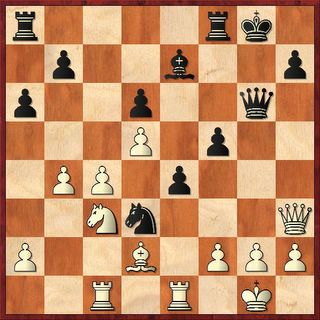Carrel,M (1119) - Prong,C (1798)
Brand New Day Cafe, 02.02.2006
Torre Attack [D03]
Make sure the young children are in bed. This game is for mature audiences only. The blunders are ghastly and gruesome.
1.d4 d5 2.Nf3 Nf6 3.Bg5 e6 4.e3 c5
This is the last book move.
5.dxc5
NCO recommends Nbd2.
5...Bxc5 6.c3 0-0 7.Bd3 Nc6 8.Qc2 h6 9.Bxf6 Qxf6 10.Nbd2 e5
Threatening an obvious pawn fork on e4.
11.e4 Be6 12.0-0-0?
Defense can be a tricky business. Before one moves a piece he should determine what piece or pieces were being defended by it. It is important to evaluate how your defensive protection scheme will be impacted by your candidate move. This is doubly important when the candidate move is a castle because two pieces are being moved, which can result in devastating consequences if played too quickly. Here white ignores the weaknesses that are created on a2 and f2 by the queenside castle. 12...Bxf2 13.Rhf1 Be3 14.Nd4?
This is dangerous because it allows black to open the c-file, which provides black an access point to the king, not to mention the potential for an absolute pin of the queen to the king.
14...Nxd4 15.cxd4 Qg5 16.Kb1 Rac8 17.Nf3
After this move I thought long and hard about RxQ NxQ Rxg2. For some reason I declined to play this line thinking that I could probably obtain a larger advantage with the queens still on the board than I would get here. This was probably the right time to lock in my advantage and simplify a bit.
17...Qd8 18.Qa4 dxe4 19.Bxe4 Qb6?
In the text Mike gains a passed pawn, but the best way to play this position was to play Nxe5. Then white has firm control of the center of the board, even material, and active piece play.
20.d5
With the black pawn on e5 there is still some doubt as to who controls the center. Black will trade off the light squared bishop for the knight on f3, and remain a pawn up.
20...Bg4 21.h3
The line 21. Bh7+ Kxh7 22. Qxg4 probably should have been investigated here.
21...Bxf3 22.gxf3
This move seemed wrong to me. First, it breaks up the connected g and h pawns to isolate both pawns. Second, the open file that is created does not have a convenient access point for the rooks.
22...Bd4 23.Rd2 Rc5 24.f4
This move loses a pawn, but gains the compensation of a half open f-file and saddles black with doubled pawns on the f-file. I don't think the compensation warrants ditching the isolated pawn.
24...Be3 25.Rc2 exf4 26.Rxc5 Qxc5 27.Qd1 Rd8
I really wanted to play Rc8, but didn't spend an appropriate amount of time investigating the move. I think I discarded the move since the passed d-pawn was gettign close to the promised land.
28.Rh1
I wondered what Mike was up to with this move. I finally concluded that he was trying to play a contrived rook lift. I guess that the target square was g2. Somehow I missed the power that the rook would have on c2 and never even considered this threat.
28...Rd6 29.Rh2
Last chance for white to avoid losing material. Qb4 or Qc4 are possible, as is the luft making g6.
29...Rb6? 30.Rc2 Qf8
The only move that gives black a chance to play on.
31.d6 g6??
I can't believe I missed Rxd6 not only keeping black in the game, but allowing him to retain a material edge.
32.d7 Rd6

33.Qxd6!
Accurate tactical play by Carrel.
33...Qxd6 34.Rc8+ Kg7 35.d8Q Qxd8
Only move that doesn't lead to mate within 6 moves according to Fritz.
36.Rxd8
At this point I had to take time to re-evaluate the game. I had still had a 6-3 pawn advantage, despite trailing by a whole rook. My assets included a passed f-pawn and the benefit of opposite colored bishops. My first goal was to secure the queenside since black only had one kingside pawn, and connected pawns on the queenside. 36...b6 37.Kc2 a5 38.Kd1
Kd3 was preferable because the king is closer to the center of the board.
38...f5 39.Bf3
Currently the light squared bishop restrains the black f-pawn. To obtain the win white should target the pawns on the light squares, since the black bishop will not be able to protect them. Furthermore, as white has two pieces to coordinate he should be able to capture any pawns that are fized on white squares.
39...Kf6 40.Ke2 Kg5 41.Kf1 Kh4 42.Kg2
White has found a square where he can both protect the bishop on f3 and the pawn on h3, however, he failes to realize that he needs the bishop to work with the rook to eliminate teh enemy pawns.
42...Kg5
I missed my chance to make a break here.
43. ...g5 43. Rh8 g4 44. Rxh6+ Kg5 45. Rh8 gxf3+ 43.Rf8 Bc5 44.Rf7 Bd4 45.b3 Bc5 46.a4 Bb4 47.Rb7 Bc5 48.Rf7 Be3 49.Rf8 Bd4 50.Rd8 Bc5 51.Rh8 Bd4 52.Rg8 Bc5 53.Rh8 Bd4 54.Rh7 Bc5 55.h4+
I thought this was good for black. The h-pawn was helping to prevent the advance of my pawns, so I was happy to trade off the h-pawns.
55...Kxh4 56.Rxh6+ Kg5 57.Rh7 Bd4 58.Rd7 Bc5 59.Rd1 Kf6 60.Bb7 g5
Black has some chances now that his kingside pawns are in motion. White should still target the pawn on the light square. So Bc8 is the right move here.
61.Kf3 Be3 62.Rd6+ Ke5 63.Rg6 g4+ 64.Kg2 f3+ 65.Bxf3
I really wasn't expecting this, but I was now only down an exchange with compensation of an extra pawn.
65...gxf3+ 66.Kxf3 Bc5 67.Rg5 Kd4 68.Rxf5 Kc3 69.Rf6 Kxb3 70.Rxb6+??
Giving away any hopes of salvaging even a half point in this game.
70...Bxb6 0-1








